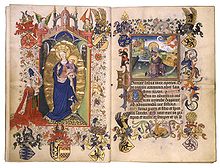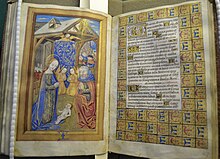

Books of hours (Latin: horae) are Christian prayer books, which were used to pray the canonical hours.[2] The use of a book of hours was especially popular in the Middle Ages, and as a result, they are the most common type of surviving medieval illuminated manuscript. Like every manuscript, each manuscript book of hours is unique in one way or another, but most contain a similar collection of texts, prayers and psalms, often with appropriate decorations, for Christian devotion. Illumination or decoration is minimal in many examples, often restricted to decorated capital letters at the start of psalms and other prayers, but books made for wealthy patrons may be extremely lavish, with full-page miniatures. These illustrations would combine picturesque scenes of country life with sacred images.[3]: 46
Books of hours were usually written in Latin (they were largely known by the name horae until "book of hours" was relatively recently applied to them), although there are many entirely or partially written in vernacular European languages, especially Dutch. The closely related primer is occasionally considered synonymous with books of hours – a medieval horae was referred to as a primer in Middle English[4] – but their contents and purposes could deviate significantly from the simple recitation of the canonical hours. Tens of thousands of books of hours have survived to the present day, in libraries and private collections throughout the world.
The typical book of hours is an abbreviated form of the breviary, which contains the Divine Office recited in monasteries. It was developed for lay people who wished to incorporate elements of monasticism into their devotional life. Reciting the hours typically centered upon the reading of a number of psalms and other prayers.
A typical book of hours contains the Calendar of Church feasts, extracts from the Four Gospels, the Mass readings for major feasts, the Little Office of the Blessed Virgin Mary, the fifteen Psalms of Degrees, the seven Penitential Psalms, a Litany of Saints, an Office for the Dead and the Hours of the Cross.[5] Most 15th-century books of hours have these basic contents. The Marian prayers Obsecro te ("I beseech thee") and O Intemerata ("O undefiled one") were frequently added, as were devotions for use at Mass, and meditations on the Passion of Christ, among other optional texts. Such books of hours continue to be used by many Christians today, such as the Catholic “Key of Heaven” prayer books, the Agpeya of Coptic Christianity or The Brotherhood Prayer Book of Lutheranism.[6]
- ^ Plummer, John (1966). The Hours of Catherine of Cleves. New York: George Braziller. pp. plates 1–2.
- ^ Pearsall, Derek (11 June 2014). Gothic Europe 1200-1450. Routledge. p. 158. ISBN 978-1-317-88952-6.
The book of hours was the favourite prayer-book of lay-people, and enabled them to follow, in private, the church's programme of daily devotion at the seven canonical hours.
- ^ Lyons, Martyn (2011). Books: A Living History. Los Angeles: J. Paul Getty Museum. ISBN 978-1-60606-083-4.
- ^ Scott-Stokes, Charity (2006). Women's Books of Hours in Medieval England: Selected Texts Translated from Latin, Anglo-Norman French and Middle English with Introduction and Interpretative Essay. Library of Medieval Women. Woodbridge: Boydell & Brewer. p. 1.
- ^ Hore de Cruce, Danish Royal Library. Archived December 24, 2008, at the Wayback Machine.
- ^ "Lutheran Liturgical Prayer Brotherhood". Evangelisch-Lutherische Gebetsbruderschaft. Retrieved 16 April 2022.
In short, the Brotherhood Prayer Book is a fully catholic book of hours refracted through the lens of the Lutheran confessions.